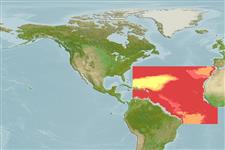>
Notacanthiformes (Halosaurs and deep-sea spiny eels) >
Halosauridae (Halosaurs)
Etymology: Aldrovandia: Taken from Ulisse Aldrovandi, (1522-1605), a Renaissance naturalist and physician noted by his systematic and accurate observations of plants and animals (Ref. 45335).
Eponymy: Dr Ulisse Aldrovandi (1522–1605) was an Italian naturalist. [...] (Ref. 128868), visit book page.
Environment: milieu / climate zone / depth range / distribution range
Ökologie
seewasser bathypelagisch; tiefenbereich 1200 - 1900 m (Ref. 4448). Deep-water; 37°N - 9°S, 74°W - 6°W
Eastern Atlantic: Gulf of Guinea region. Western Atlantic: off Virginia, USA to Bahamas, Venezuela and the Guianas. Eastern Central Pacific (Ref. 9305) and Chile (Ref. 9068).
Size / Gewicht / Alter
Maturity: Lm ? range ? - ? cm
Max length : 52.0 cm TL Männchen/unbestimmt; (Ref. 4448)
Rückenflossenweichstrahlen (insgesamt) : 9 - 10. Anus white, surrounded by dark field; body dark brown, head black (Ref. 13608).
Found at bathyal depths. Feeds on polychaetes. Males exhibits black tubular anterior nostrils and enlarged posterior nostrils when approaching breeding condition.
Life cycle and mating behavior
Geschlechtsreife | Fortpflanzung | Ablaichen | Eier | Fecundity | Larven
Sulak, K.J., 1990. Halosauridae. p. 126-132. In J.C. Quero, J.C. Hureau, C. Karrer, A. Post and L. Saldanha (eds.) Check-list of the fishes of the eastern tropical Atlantic (CLOFETA). JNICT, Lisbon; SEI, Paris; and UNESCO, Paris. Vol. 1. (Ref. 4448)
IUCN Rote Liste Status (Ref. 130435: Version 2024-1)
Bedrohung für Menschen
Harmless
Nutzung durch Menschen
Fischereien: nicht kommerziell
Tools
Zusatzinformationen
Download XML
Internet Quellen
Estimates based on models
Preferred temperature (Ref.
123201): 4.2 - 6.5, mean 4.3 °C (based on 37 cells).
Phylogenetic diversity index (Ref.
82804): PD
50 = 0.5156 [Uniqueness, from 0.5 = low to 2.0 = high].
Bayesian length-weight: a=0.00085 (0.00033 - 0.00223), b=3.07 (2.84 - 3.30), in cm total length, based on LWR estimates for this (Sub)family-body shape (Ref.
93245).
Trophic level (Ref.
69278): 3.1 ±0.26 se; based on food items.
Widerstandsfähigkeit (Ref.
120179): niedrig, Verdopplung der Population dauert 4,5 - 14 Jahre. (Assuming tmax>10).
Fishing Vulnerability (Ref.
59153): Moderate vulnerability (41 of 100).
